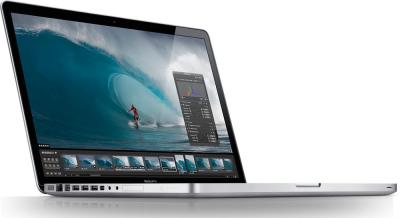The new MacBook Pro models released by Apple in late February take new strides in graphics performance and will allow the company to show off the forthcoming Lion release of Mac OS X on an elegant but powerful computing platform. It breaks new ground in storage by offering a powerful new interface that could make the bottleneck of external storage a not-so-fond memory. This year’s edition of Apple’s premium portable notebook computer should prove to be a good investment for anyone requiring a high-power machine for gaming or video processing, and for the casual user, it won’t be “just another upgrade.”
This round of MacBook Pros are powered by Intel’s latest generation of processors, the 32nm “Sandy Bridge” series, with quad-core Core i7 processors in the case of the 15- and 17-inch models. The 13-inch models are available with either a dual-core 2.3GHz Core i5 or a dual-core 2.7Ghz Core i7 processor. The basic 15-inch MacBook Pro now features a quad-core 2.0 GHz i7, with the option of upgrading to the same quad-core 2.2 GHz CPU that the 17-inch model sports, or a quad-core 2.3GHz CPU.
The 15- and 17-inch models also include the addition of an AMI Radeon 6750 GPU for the 17- and top-end 15-inch models, and an AMI Radeon 6490 on the basic 15-inch machine. The “better” 15- and 17-inch model have 1GB of video memory, the basic 15-inch has 256MB of memory and the 13-inch models use 384MB of shared memory. All models use an Intel HD Graphics 3000 GPU to handle workhorse graphics processing. The Radeon GPU is reserved for (on those machines so equipped) speciality work, and the result is a significant improvement in graphics performance over last year’s model.
Notably Faster
In initial benchmark testing of a “better” 15-inch, with 4GB of memory and a 750GB hard drive partitioned for Mac OS X and Microsoft Windows, I found an almost 50 percent performance improvement in graphics-heavy applications for the better of the 15-inch models, compared to the result of similar testing I performed last year. Even prosaic areas such as storage show more than mere incremental improvements over last year. My own machine of the 2007 vintage is starting to look rather ragged in comparison.
For my benchmarking, I used essentially the same test plan as before. I installed 64-bit Windows 7 via the Mac OS X Boot Camp dual boot feature, and followed with the Futuremark PCMark Vantage benchmarking suite. I then ran three passes of the PCMark Vantage tests on an installation of Windows 7 patched up to early March 2011. This was done first without, and then with, the recently released Service Pack 1 for the operating system.
Compared with a similarly equipped MacBook Pro of last year, the benchmarks showed an overall score improvement of 23 percent. In the graphics-intensive gaming and multimedia categories, the new MacBook Pros rang up improvements ranging from 35 percent in “Memories” to a rather impressive 48-51 percent in “TV & Movies” and 46-47 percent in “Gaming.”
My testing indicated 11-12 percent improvement in the “Hard Disk” score, and a 6-12 percent improvement in “Communications.” The remaining categories of “Music” and “Productivity” showed improvements of 6-7 percent for the former and 15 percent for the latter.
Two-Way Shock
This latest generation of MacBook Pros all offer as part of the basic package for connectivity Bluetooth, Gigabit Ethernet and 802.11n WiFi networking. All models have two USB 2.0 ports, a FireWire 800 port, an SDXC card slot and, replacing the Mini DisplayPort of recent MacBook Pros, the next big thing in expansion technology. Apple calls it Thunderbolt, and it is the company’s implementation of Intel’s new Light Peak technology, which claims the ability to sling data at speeds up to 10G bps.
In the short term, this ability doesn’t mean much to users because the external devices such as disk arrays and removable storage that will be benefit from Light Peak-Thunderbolt don’t exist yet. But that won’t be a problem for long. Promise Technologies expects to begin shipping a Thunderbolt RAID unit in the second quarter, and LaCie appears to be in the lead to offer the first Thunderbolt removable storage device, with availability in summer 2011.
But in the long term, ultra-high-speed file transfer such as that offered by Light Peak-Thunderbolt is going to make a big difference by enabling users to slosh around terabytes of data quickly. This may be a curse as well as a blessing for some organisations, as they will find it necessary to rethink device management strategies and adopt tools that can exert the same controls over the Thunderbolt port as they currently have on the FireWire, SD Card and USB ports.
Other notable options include a 1680 by 1050 display, in antiglare or glossy finishes, and the built-in camera (formerly the iSight, now branded by Apple under the FaceTime videoconferencing label) that captures 1280 by 720 HD video. Solid-state drive options range from 128 to 512GB, and a 750GB 5400 rpm drive is standard on the “better” 15-inch and 17-inch models.
Overall, the new MacBook Pro is going to delight the Apple customer, and provide the company with a solid showcase for the next step in the evolution of its desktop operating system, with only a few more months left until the release of Mac OS X Lion. It is in many ways far more than the incremental improvements expected in “this year’s machine,” whatever the year. As the first computer to support the Light Peak-Thunderbolt specification, it marks the most dramatic advancement that Apple has made in the area of connectivity in the quarter century since it declared SCSI a standard feature of the Macintosh Plus.





